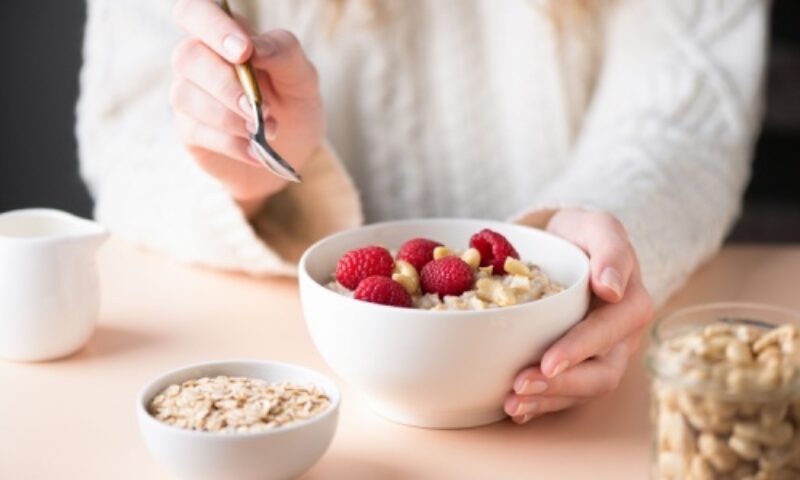Most adults don’t get enough fibre in their diet, and it could cause health problems.
Government guidelines say a healthy balanced diet should include 30g of fibre a day, but most adults only eat an average of 20g.
Read on to learn more about the benefits of fibre for your health and the ways you can increase your intake.
Adding more fibre to your diet could reduce health risks
Fibre is a plant-based carbohydrate found in foods, such as whole grains, fruits, and vegetables, and it is essential for your health.
Your body breaks down nutrients, such as fats, proteins, and other carbohydrates, but fibre passes mostly intact through your stomach and intestines, which benefits your digestive system.
In fact, fibre-rich diets are associated with a lower risk of:
- Stroke
- Heart disease
- Type 2 diabetes
- Bowel cancer
- Constipation
Fibre also takes a while to digest, which means you feel full for longer and are less likely to overeat.
How to increase your fibre intake
If you want to make sure you’re eating the recommended amount of fibre, read on to discover our top 10 tips.
1. Check the labels
Some foods may advertise themselves as high in fibre, but what does that really mean?
Double-check the nutrition labels when you’re choosing your food. A food counts as “high in fibre” if it contains 6g of fibre per 100g.
Keeping a note of the labels can also help you track how much fibre you’re eating in a day to ensure you’re hitting your target.
2. Switch to whole grains
Many supermarkets offer wholegrain alternatives for foods such as pasta, bread, and rice.
These contain a higher fibre content than the white alternatives, as well as being packed with other nutrients such as vitamin B and iron.
3. Get your 5-a-day
Fruits and vegetables are fantastic sources of fibre, so aiming to eat five varieties every day can help you improve your diet.
Try filling your plate with at least two different coloured vegetables during your main meal, or sneak some salad into your sandwiches for lunch.
4. Eat more pulses
Pulses – such as beans, lentils, or chickpeas – are a great fibre-rich addition to your meals.
They are perfect for dinners such as stews, curries, and salads, and can also function effectively as replacements for meat if you are trying to eat more vegetarian or vegan dishes.
5. Stock up on cans
Fibre doesn’t only come from fresh food.
Frozen, dried, or tinned fruit, vegetables, and pulses all count towards your fibre intake and can make your life easier by already being prepared and ready to eat.
6. Snack healthily
If you like having something to eat between meals, you’ll be pleased to hear there are plenty of sweet and savoury snacks that are high in fibre.
Some options include:
- Popcorn
- Flapjacks
- Unsalted nuts and seeds
- Vegetables and hummus
- Wholegrain crackers, such as rye
- Slices of fruit dipped in nut butter.
If you want to bake sweet treats, try to use wholewheat or oat flour, and look for recipes that incorporate fruit and vegetables, such as carrot cake or banana bread.
7. Don’t peel your potatoes
Whatever kind of potatoes you prefer – baked, boiled, or even a sweet potato – keeping the skins on can help you to add more fibre to your diet.
Even if you were planning on making mash, you can keep the skins for another day so you aren’t wasting the fibre.
8. Consider your breakfast choices
There are a lot of easy switches you can make for your breakfast meals.
For example, choosing wholegrain cereal or wholewheat bread for toast can help you eat more fibre.
Oats can also be a great source of fibre if you have time to make porridge in the mornings, and adding a few slices of fruit to the top can make it even healthier.
9. Don’t use fibre supplements
Unless instructed otherwise by your doctor, fibre supplements might be a waste of money.
Potatoes, oats, beans, and many of the other foods that have made it onto this list are the cheapest and most filling foods around, and could be the best way to reach your fibre goals instead of turning to supplements.
10. Small changes add up
It’s important to remember that even small switches can add up to a big change in your diet.
If you’re feeling overwhelmed by the amount of food you think you need to change, start one step at a time. Even adding some vegetables to a pizza or eating whole fruit rather than fruit juice can help you move one step closer to your goal.

